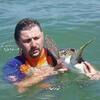Research and Involvement of Local Communities to E
The Marine Protected Area (MPA) of Cerro Verde (Rocha) has been shown to be one of the most important foraging habitats for green turtles (Chelonia mydas) in Uruguay and a migratory pathway for loggergheads (Caretta caretta) and leatherbacks (Dermochelys coriacea). However, fishing activities and marine debris threaten the survival of these endangered species.
The research activities of this project will determine the main causes of death and evaluate how fishing activities and solid marine debris contributes to sea turtles mortality. In the other hand, the environmental education activities to be performed will involve local fishermen and school students in conservation activities in order to reduce sea turtles mortality.
Sea turtles stranding events will be monitore along the MPA, the cause of death will be assessed and gastrointestinal contents will be analysed. Workshops about sea turtles reanimation and release techniques as well as the impacts on the marine ecosystem of dumping plastic fishing gear, synthetic material and ghost nets will be perform with local fishermen. Participative research on marine debris will be carried out with school students, and the results will be exposed in mini symposiums held at the local schools. During the development of the “Saving the Sea Turtle” festival week, performed by Karumbé every year, resusable cloth bags will be printed by the students and handle out among local communities in order to replace plastic bags. Extra cloth bags will be produced in order to introduce them in the local markets and be sell to tourists during the public awarness campaign developed by Karumbé every year.
The results of this project will be critical to make grounded decisions and recomedations for the development of the management plan of the MPA. Evenmore, raissing awareness within the key actors by involving them in conservation efforts will ensure the sustainable development of the area.
For further information contact aloluciana@gmail.com
